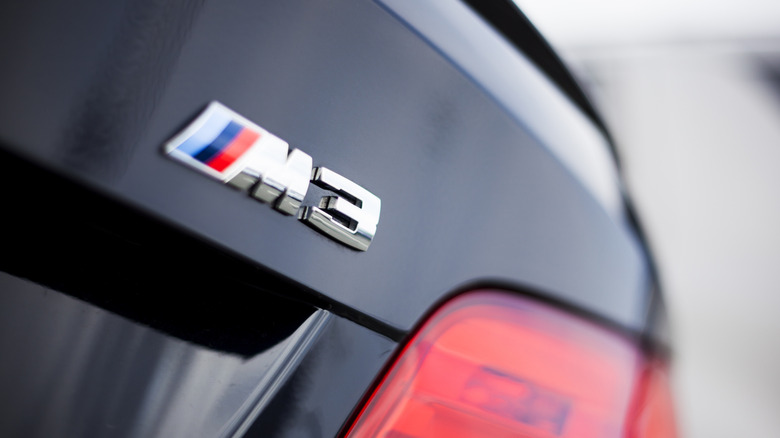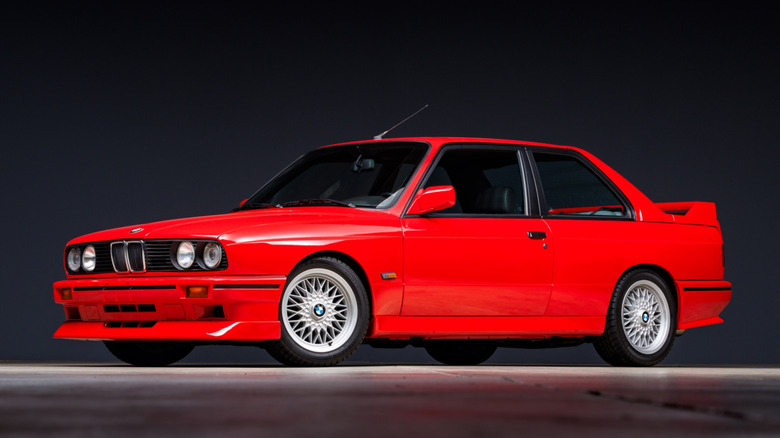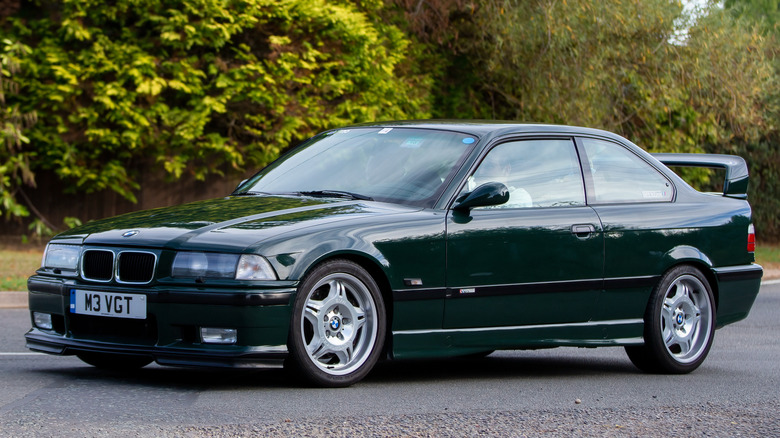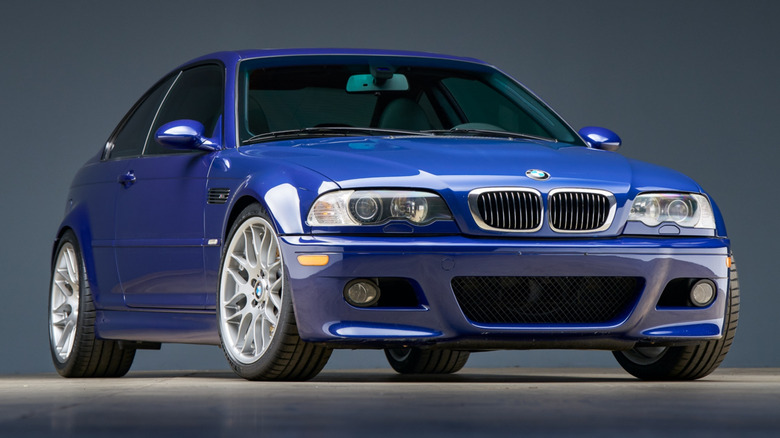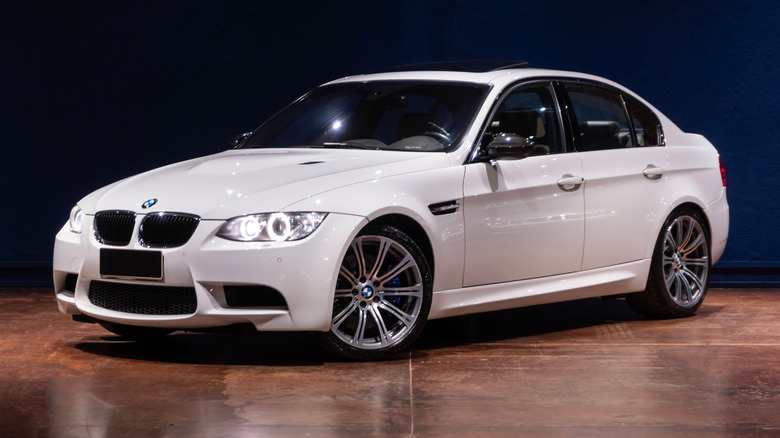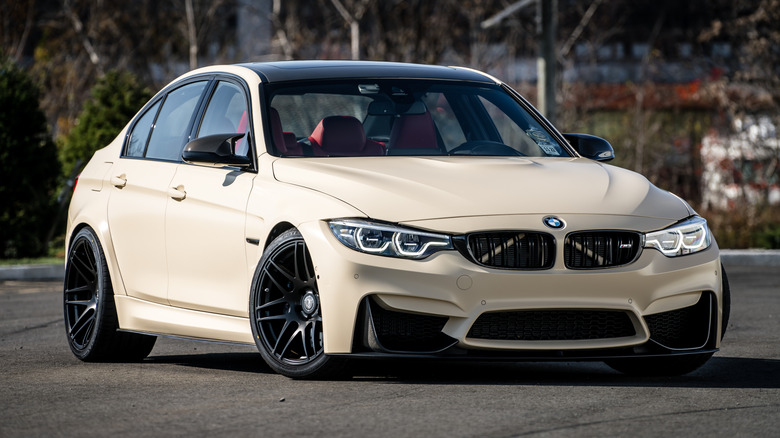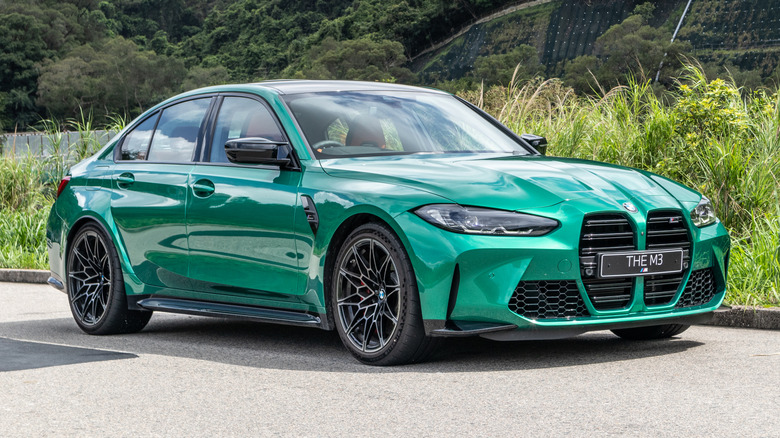Every BMW M3 Generation Ranked By Horsepower
German cars are known for a lot of things. They're somehow no-frills, straight-to-business vehicles that are still very over-engineered. They flash a closed-lip smile and give a curt nod to their passengers as they comfortably cruise the autobahn, likely wearing a color somewhere between black and white. They're also very fast, and each of the big three German automakers — Audi, Mercedes-Benz, and BMW — have a special trim level dedicated to performance. Audi has its RS line, which stands for "RennSport" in German (and "racing sport" in English). Mercedes has AMG, which stands for the German mouthful, "Aufrecht Mechler and Großaspach," (the names and birthplace of AMG's founders), and BMW has M.
But what is M? According to BMW, M is "the most powerful letter" and simply stands for motorsport. Created in 1972, the M division was meant to expand the brand's offerings to include more performance-oriented cars, with its first creation being the BMW M1. Over time, the division grew, and its catalogue expanded along with its capabilities. Cars like the M5 and M Roadster put BMW on the map as a real power player on track days and in professional motorsports alike, but there is perhaps no M car more famous or recognizable than the M3. Since its inception, the M3 has been the poster child for the M division, and it's a staple in this lineage of horsepower and lap times. Here's every BMW M3 generation ranked by horsepower.
BMW M3 E30
From the beginning, the BMW E30 M3 was a child of motorsport. The first iteration from 1986 only came to be because of the German Touring Car Championship's (or DTM's) homologation rules. Some racing series like DTM require that a company create a road-going version of the track car with which it wishes to race. This version is then referred to as the track car's homologation model. In this instance, the DTM's rules required BMW to create 5,000 homologation models, but the M3 was so popular, customers wanted more. This high demand resulted in a production run of 16,949 M3s, and it was a true race car for the road.
The only body panels this derivative shared with the regular 3 Series were the doors and roof. It made use of all the era's newest technologies, making it a state-of-the art, road-ready weapon that anyone could buy — if they had the money, of course. It used ventilated brake discs to maintain consistent stopping power under hard use, as well as a manual transmission to give the driver control over the engine, which was a 2.3-liter, naturally aspirated four-cylinder that produced 195 horsepower. It boasted the boxy style of '80s sports cars, which remains a hit even now. Its looks and performance are part of why it's so expensive today, but its history is what makes it truly special.
BMW M3 E36
In 1992, six years after the E30's introduction, BMW released the E36. This new M3 kept its eyes on the performance prize but added some everyday sensibility to the madness of the previous generation. The most obvious change was that the E36 was available as a sedan, allowing the driver and four passengers to race down any highway like it was the autobahn. The other noticeable change was to the engine. The E36 received a six-cylinder layout that came with better performance. Its styling also made it more desirable, with a slightly more executive look than its predecessor, but the E36 was by no means tame.
Its engine was naturally aspirated and featured a new performance upgrade that BMW called VANOS. The VANOS system allowed the ECU to adjust the camshaft and valve timing to produce more torque in the low and mid ranges of the power band. Beyond the engine bay, the E36 also featured the usual sport treatment, including stiffer suspension and upgraded brakes, all of which were designed to supplement the car's 286 horsepower. On the outside, the E36 was noticeably slimmer than the E30, with a small kidney grille, angel eye headlights up front, and an angular yet slim silhouette. The E36 was the next logical step after the E30, and not only has it remained a desirable M car since its creation, but it's now a rising star in the car community.
BMW M3 E46
The next evolution of the M3 line came in 2000 under the generation name E46. The model took the formula of unmatched power and performance, mixed it with the previous generation's everyday usability, and perfected it. As with all M3s, it was based on the regular 3 Series, but this one was dressed to impress. The E46 was a very pretty car with small but noticeable fender flares, vents behind the front fenders, extended side skirts, and a bulging, muscular hood that BMW called the "powerdome." By this point, the M3 was an established nameplate that garnered attention and desire from many customers, so it's unsurprising that BMW made 85,139 units of the E46.
Under the hood, this generation was, of course, all about performance. It took the six-cylinder engine layout that premiered with the previous generation and improved upon it. Called the S54B32, it held 3.2 liters of displacement and produced 343 horsepower. What really made this engine special, however, was its redline — it quickly revved all the way to 8,000 rpm. The S54 was a truly special engine, and it reigned as Engine of the Year from 2001 to 2006. All of this made the E46 one of the most loved M3s, so much so that it could be a future classic.
BMW M3 E90
By 2007, BMW was due for another M3, and its new iteration, the E90, proved to be a very unique evolution. The E90 was the most muscular M3 at the time, both inside and outside of the engine bay. This car was extensively different from its regular 3 Series counterpart and was much wider and longer than the previous E46 M3. It featured a carbon fiber roof to help lower its center of gravity, and it smoothed and modernized much of the visual design cues of previous models. Despite its larger size, the E90 managed to save weight in some key areas, one of which was the engine.
The E90's engine is what really made this generation stand out. For the first and only time, the M3 received a V8 that BMW called the S65B40. The biggest M3 engine at the time, the S65 V8 held a 4.0-liter displacement, and yet it weighed almost 450 pounds less than the six-cylinder before it. The car also produced 420 horsepower and screamed up to 8,300 rpm, producing real race car theatrics and performance. Thanks to its double-VANOS system, the S65 was more than capable even at lower revs, with 340 nm of torque already available at 2,000 rpm. It also included the new M drive transmission, which included dual clutch plates for faster shifts, proving that the E90 was the M3 of the future.
BMW M3 F80
Fast-forward seven years to 2014 and the next M3, the F80 generation, arrived on the scene. The introduction of the F80 M3 marked an important chapter in the world of M cars, as the two-door coupe version was called the M4 from that point forward, with the M3 remaining as the four-door sedan. Beyond the naming technicalities, though, the new M3 was a stunning achievement. Much of what made it so special was in the engine bay. For the F80, the M engineers went back to the traditional six-cylinder engine layout, with the added special ingredient of turbochargers.
While the new S55B30 didn't rev as high as its ancestors — it capped out at 7,600 rpm — it was the strongest of its time, producing 431 horsepower. The F80 was comparatively light, too, weighing in at around 3,500 pounds. This was thanks to a carbon fiber roof, prop shaft and engine brace, along with an aluminum hood. This was also the first M3 generation to receive the Competition package. In the past, some BMWs wore a CSL badge, which stood for "Competition Sport Lightweight" and was reserved for cars that shed pounds, often at the cost of practicality and usability. The new Competition trim option kept all the performance upgrades synonymous with the CSL idea — without cutting the weight. In the Competition model, the M3 bumped up power to 450 and received upgrades to the suspension and exhaust system.
BMW M3 G80
In 2020, BMW revealed a new generation of the M3: the G80. The biggest updates are to the exterior. The G80 took a bold — or foolish, depending on who you ask — step forward with dramatic changes to the M3's styling. Gone was the rounded and reserved kidney grille that Bimmer fans had grown accustomed to, replaced with a pair of gaping intakes that stretched from the top to the bottom of the front fascia. The lines of the G80 felt more aggressive than the M3s of days past, but the car's performance matched this fiery look. The G80 continued with the twin turbo, six-cylinder setup that debuted in the F80, which now produced 480 horsepower in the standard M3 and 510 horsepower in the M3 Competition. While the Competition model enjoyed performance upgrades, only the standard M3 came with the option for a manual transmission.
Across all of its trim levels, the G80 M3 implemented a few new technologies. One was the Adaptive M Suspension system. This was a highly customizable feature that allowed the driver to adjust the car's suspension to be stiffer or softer depending on the desired driving dynamics. Similarly customizable was the M-specific braking system. This allowed the driver to adjust the sensitivity of the brake pedal to their preferences and the situation. Regardless of its polarizing looks, these features and its more-than-capable engine make the G80 the most technologically advanced and high-performing M3 yet.
